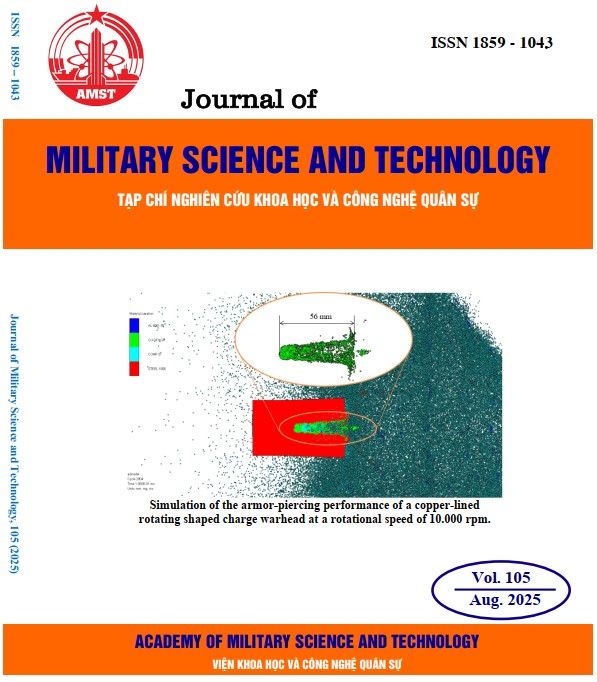Nghiên cứu đánh giá hiệu quả xử lý nitrate trong nước của than sinh học biến tính chế tạo từ vỏ cà phê
302 lượt xemDOI:
https://doi.org/10.54939/1859-1043.j.mst.105.2025.75-82Từ khóa:
Hấp phụ; Than sinh học; Vỏ cà phê; NO3-.Tóm tắt
Bài báo này giới thiệu kết quả nghiên cứu chế tạo và đánh giá khả năng hấp phụ nitrate trong nước của than sinh học biến tính chế tạo từ vỏ cà phê. Vỏ cà phê được nhiệt phân ở 350 oC, 1 h, sau đó ngâm với KOH 1 M trong 24 h, nhiệt phân tiếp ở 700 oC trong 2 h. Sản phẩm sau chế tạo được đánh giá đặc tính bằng FT-IR, BET, SEM và khảo sát hiệu quả xử lý nitrate trong nước. Tại pH = 3, tỷ lệ than 1,5 g/100 mL dung dịch NO3- 50 mg/L, thời gian hấp phụ 210 min cho hiệu quả xử lý nitrate đạt cao nhất (82,38%). Mô hình động học biểu kiến bậc 1 và mô hình hấp phụ đẳng nhiệt Langmuir đã được xem xét và co thấy sự phù hợp để mô tả quá trình hấp phụ của than sinh học biến tính.
Tài liệu tham khảo
[1]. Case studies in enviromental medicine-nitrate/nitrite toxicity, ATSDR, (2013).
[2]. R. Picetti et al., “Nitrate and nitrite contamination in drinking water and cancer risk: A systematic review with meta-analysis”, Environ. Res., 210, 112988, (2022). DOI: https://doi.org/10.1016/j.envres.2022.112988
[3]. A. Kapoor, T. Viraraghavan, “Nitrate removal from drinking water-review”, J Environ. Eng., 123, pp. 371-380, (1997). DOI: https://doi.org/10.1061/(ASCE)0733-9372(1997)123:4(371)
[4]. J. Younker , L. Zamlynny, C. Spearns, J. Rand, “Nitrate management in a rural drinking water supply”, J Water Process Eng., 43, 102301, (2021). DOI: https://doi.org/10.1016/j.jwpe.2021.102301
[5]. H.H. Kinfu et al., “Metal-phenolic network-based NF membranes for nitrate removal and the utilization of DSPM-DE model”, Chemical Engineering Journal. 162841 (2025). DOI: https://doi.org/10.1016/j.cej.2025.162841
[6]. J. Li, J. Li, H. Mu, H. Xie, W. Zhao, “Immobilization Technology of Aerobic Denitrifying Bacteria and Its Enhanced Biological Denitrification: A Review of Recent Advances”, Water. 17, 1433, (2025). DOI: https://doi.org/10.3390/w17101433
[7]. Z. Zhang, Y. Zhang, and Y. Chen, “Recent advances in partial denitrification in biological nitrogen removal: From enrichment to application”, Bioresource Technology, 298, 122444, (2020). DOI: https://doi.org/10.1016/j.biortech.2019.122444
[8]. S. Muhammad et al., “Insights into agricultural-waste-based nano-activated carbon fabrication and modifications for wastewater treatment application”, Agriculture, 12, 1737, (2022). DOI: https://doi.org/10.3390/agriculture12101737
[9]. https://nongnghiepmoitruong.vn/gia-tri-cua-vo-ca-phe-d229843.html
[10]. Z. Heidarinejad et al., “Methods for preparation and activation of activated carbon: A review”, Environmental Chemistry Letters, 18, 393-415, (2020). DOI: https://doi.org/10.1007/s10311-019-00955-0
[11]. N.-T. Vu, and K.-U. Do, “Insights into adsorption of ammonium by biochar derived from low temperature pyrolysis of coffee husk”, Biomass Conversion Biorefinery, 13, 2193-2205, (2023). DOI: https://doi.org/10.1007/s13399-021-01337-9
[12]. Hafshejania et al., “Removal of Nitrate from Aqueous Solution by Modified Sugarcane Bagasse Biochar”, Ecological Engineering, 95, 101-11, (2016). DOI: https://doi.org/10.1016/j.ecoleng.2016.06.035
[13]. Viglašová et al., “Production, Characterization and Adsorption Studies of Bamboo-Based Biochar/Montmorillonite Composite for Nitrate Removal”, Waste Management, 79, 385-94, (2018). DOI: https://doi.org/10.1016/j.wasman.2018.08.005







